Tillandsia Hal's Nidus
Click thumbnails for full size, scaled to a new window.
Tillandsia Hal's Nidus
Variously known in Australia as T. fasciculata "Minor", T. nidus, or T. x nidus
Listed in BCR as.. "Aust. 1980s import by Victorian grower Hal Ellis as T. fasciculata "Minor". Later linked to species T. nidus (1983), then natural hybrid T.x nidus but not known if different hence the cultivar name. Reg. Doc. 12/2009 by D. Butcher See similarity with 'Coquette'.
Seed parent fasciculata “Minor”"
See notes below, particularly for "fasciculata minor x velutina" and "velutina x fasciculata".
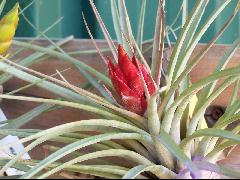

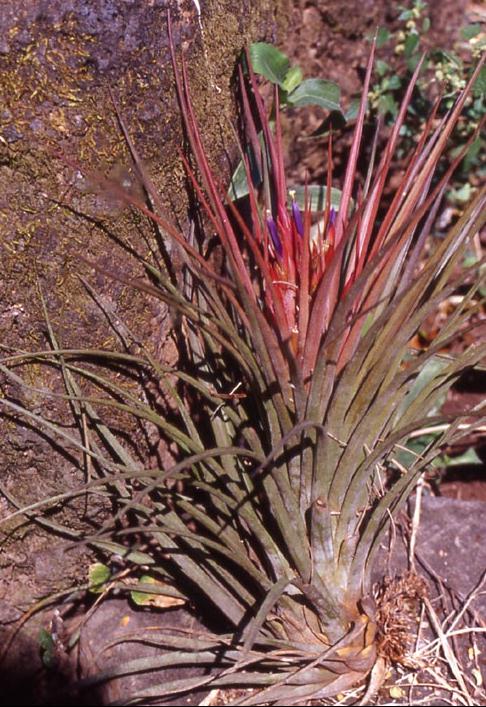

| Mark Supple as fasciculata 'Minor' |
T. xnidus in Coatepec, EM060302, R.Ehlers. |
John Olsen 12/19 as Hal's Nidus |
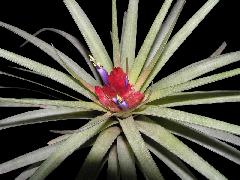

Photo Ken Woods 02/08..."Possibly hybridised by Barry Genn, and labelled as such by Neville Ryan."
Suggested by Derek Butcher as Hal's Nidus. |
DD1209 Tillandsia Hal’s Nidus.
by Derek Butcher December 2009
This plant became a Tillnuts discussion when Mark Supple of Newcastle showed a photo of a flowering plant of his called T. fasciculata ‘Minor’. As you all know, I shudder at the use of this adjective because it means there are differences between this this plant and the species but nobody has bothered to define what these differences are. The advantage of Tillnuts is that we are all terrible poker players and love to show our hand so others can get involved. This was no exception where it appears this plant started its Australian life in the 1980’s when Hal Ellis from Victoria was importing plants with Garry Thompson. As is usual, offsets get exchanged and Chris Larson was not happy with the name ‘minor’ and started investigating. He even cornered Renate Ehlers at the Adelaide Conference in 1995. It was felt that the plant could be Rauh’s T. nidus which was still a somewhat unknown quantity at that time. Nothing further was done other than Chris and Maurice Kellett changing their name to T. nidus.
For the first time we will now show what Rauh said in 1983 but in English!
Tillandsia nidus - Rauh & Lehmann, Trop. Subtrop. Pflanz. 41: 19-22. 1983
Plant stemless, flowering to 20cm high, Leaves numerous, narrow, erect, occasionally secund, making a large rosette 5 – 6cm diam.
Leaf sheath indistinct, ca 3cm long, 1.4cm wide, pale brown lepidote.
Leaf blade erect, narrow triangular, to 20cm long, 1.4cm wide near sheath, channelled, long attenuate, green, dense grey lepidote.
Scape very short, 2 – 3cm long, 4mm thick.
Scape bracts 2 – 3, membranous, ca 2cm long, much shorter than the primary bract.
Primary bract leaflike, erect, the bottom ones with its sheath as long as the spike with long filiform dense grey lepidote blade, the upper ones shorter.
Inflorescence nestling, exceeded by the leaves, 8 – 10cm long, 5 – 8cm wide, densely bipinnate, with 10 – 14 erect, complanate, short stemmed, 4 – 5cm long, 1.5cm wide, ca. 5 flowered spikes.
Flower bracts densely imbricate, ca. 4cm long, 1.2cm wide, keeled, with short hooked tip, membranous, carmine red, at the bottom green, laxly lepidote, smooth, (when dry strongly nerved) much exceeding the sepals.
Sepals 25mm long, 6mm wide, acuminate, keeled, membranous, free, reddish at tip, otherwise whitish.
Petals 4cm long, 3mm wide, pale violet with white edges and a blunt weakly reflexed tip.
Stamens and Style protruding. Filament 22mm long. anther 7mm long.
Ovary 7mm long.
Habitat central Mexico without exact location.
Holotype BGH 46 409 in Heidelberg (HEID)
T. nidus had already been known for a long time by J. Zehnder, Kaktimex, Switzerland, without collection data and reached Dr. J. Rutschmann, Basel, as T. diguetii Mez on the basis of the nesting, deeply inserted inflorescence in the leaf rosette, and was sent to the collection in the Botanical garden Heidelberg. As such, it was published as a colour photograph by Rauh in the Journal of The Bromeliad Society Vol. XXXI, No., 5, 1981, pages, 218-219. Investigation has yielded however that it is not T. diguetii, because this plant resembles a young T. seleriana Mez with sessile inflorescence and amongst other things the base of the leaf rosette is a pseudo-bulb. Compared to T. nidus, T. plagiotropica Rohweder, has a flat spreading rosette ( fig. 9).
T. nidus may be one of the many natural hybrids, that have recently become known from Mexico.
Note – no mention made of reddening in the centre at anthesis.
Things have moved on since then because the next reporting we got was that De Rebus I, 1994 indicated this was a natural hybrid of fasciculata x ionantha. Note that we still did not know where it could be found in the wild! We do know that by 1997 Birdrock had it in their catalogue but no location. We do know that Renate Ehlers collected the plant in 2006 near Coatepec in the State of Vera Cruz, Mexico. We do know that with natural hybrids, back crossing occurs making it difficult to know what range this hybrid might have.
This then is what we know about the plant in the wild but can we link a plant imported in the 1980’s to T. nidus or T.xnidus? The safer option is to give this clone the name of T. ‘Hal’s Nidus’ and to use Mark Supple’s photo as an example. The reason why I picked the name is that if your plant can be traced to Hal Ellis or has a suspect name like ‘nidus’ you can at least follow the threads. There are certainly other plants that look similar to this plant and have doubtful pedigree which could be linked to ‘Hal’s Nidus’ but that is the decision of the owners.
As for the future where someone is trying to identify a plant at least we have photos of what we consider typical T. fasciculata, T. nidus and T. ‘Hal’s Nidus’
UPDATE !
Tillandsia 'Hal's Nidus' to the Aussies and 'Coquette' in the USA by Derek Butcher 9/2015
First, let us look at Tillandsia nidus described by Rauh in 1983 as a species found somewhere in Mexico some years before. We even had a wrong photo in Journ Bot Soc 31(5): 218-9.1981 and it was finally decided by Harry Luther that it was a natural hybrid between T. fasciculata x ionantha. Note that we still did not know where it could be found in the wild! We do know that by 1997 Bird Rock Tropicals nursery, California had it in their catalogue but no location. We do know that Renate Ehlers collected the plant in 2006 near Coatepec in the State of Vera Cruz, Mexico. We do know that with natural hybrids, back crossing occurs making it difficult to know what range this hybrid might have.
Now we go the Australia, where this plant became a Till discussion group relay discussion when Mark Supple of Newcastle showed a photo of a flowering plant of his so-called T. fasciculata "Minor". Here we had the same name used for at least two different looking plants with the more common one having a single spike and it was eventually added to the BCR in 5/2015 as Tillandsia "Minor". As you all know, I shudder at the use of such adjectives when linked to a species name because it means there are differences between this plant and the species, but nobody has bothered to define what are these differences. The advantage of the Till discussion group is that we are often terrible poker players and love to show our hand so others can get involved. This was no exception where it appears this plant started its Australian life in the 1980s when Hal Ellis from Victoria was importing plants with Garry Thompson. As is usual, offsets get exchanged and Chris Larson was not happy with the name "minor" and started investigating. He even cornered Renate Ehlers at the Adelaide Conference in 1995. It was felt that the plant could be Rauh’s T. nidus which was still a somewhat unknown quantity at that time. Nothing further was done other than Chris and Maurice Kellett changing their plant name to T. nidus.
This then is what we know about the plant in the wild but can we link a plant imported in the 1980’s to T. nidus or T. xnidus ? The safer option was to give this clone the name of T. ‘Hal’s Nidus’ and to use Mark Supple's photo as an example. The reason why I picked the name is that if your plant can be traced to Hal Ellis or has a suspect name like 'nidus' you can at least follow the threads. There are certainly other plants that look similar to this plant and have doubtful pedigree which could be linked to 'Hal's Nidus' but that is the decision of the owners.
As for the future where someone is trying to identify a plant at least we have photos of what we consider typical T. fasciculata, T. nidus and T. 'Hal's Nidus'.
Now to phase 2. In May 2015 Ross Little reported that his Pinegrove Nursery ledger revealed Tillandsia fasciculata hybrid – "Guatemala BBK #2662, 5/86 Gleeson" AND he was still growing the plant under this name. It looked like ‘Hal’s Nidus’. May 1986 is a long while ago and what happened to the offsets that escaped from Pinegrove? Were they grown on as T. fasciculata hybrid? I suggest very little happened but with growers trying to guess father, for example T. nidus and T. velutina. T. velutina is an interesting one because it was not described until 1994 and Tillandsia fasciculata x velutina has recently gained notoriety with a Gardening Guru on TV. As you also know I dislike formulas because you never know who coined the formula unless you ask questions.
Because nobody has reported importing other than these two references all these lookalikes should be linked to 'Hal's Nidus'.
Now to phase 3. On 8/2011 Dennis Cathcart registered a T. 'Coquette' for an alleged natural hybrid found in Guatemala which Harry Luther had decided was probably (rotundata x capitata). We do not know who may have imported this to Australia but we do know that Pam Hyatt was selling TX137 at the World Conference in Cairns in 2008. TX137 became 'Coquette' too. John Olsen tells me that there seemed to be few for sale but he bought one which still has TX137 on the label.
Are you interested in having an almost correct name on your plant and I don't mean formula? Nobody has dissected a (rotundata x capitata) or even a (fasciculata x query) to show they are the same even though they look it. If you can trace your plant to its origins you will know what name to use. If you cannot, then put the problem at the door of those who change labels without recording their actions and just call it Tillandsia hybrid.
Acknowledgements:
Thanks to Ross Little and Geoff Lawn for their valued input.
The following is a transcript, and pictures (following), from the Tillandsia discussion group on 'Hal's Nidus', 'Coquette' and 'Minor'.
Greg Aizlewood 12/05/15. Images 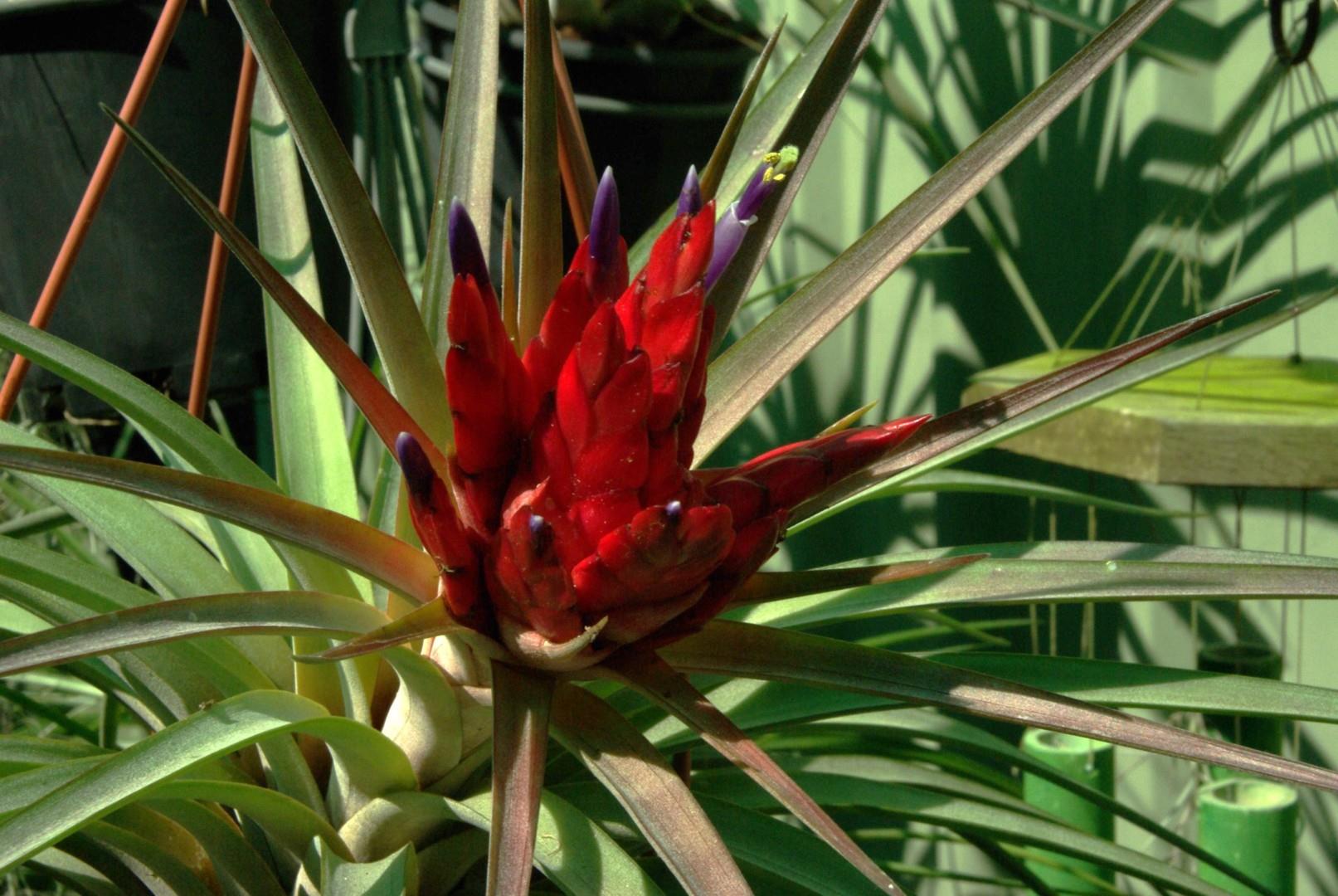 ,
, 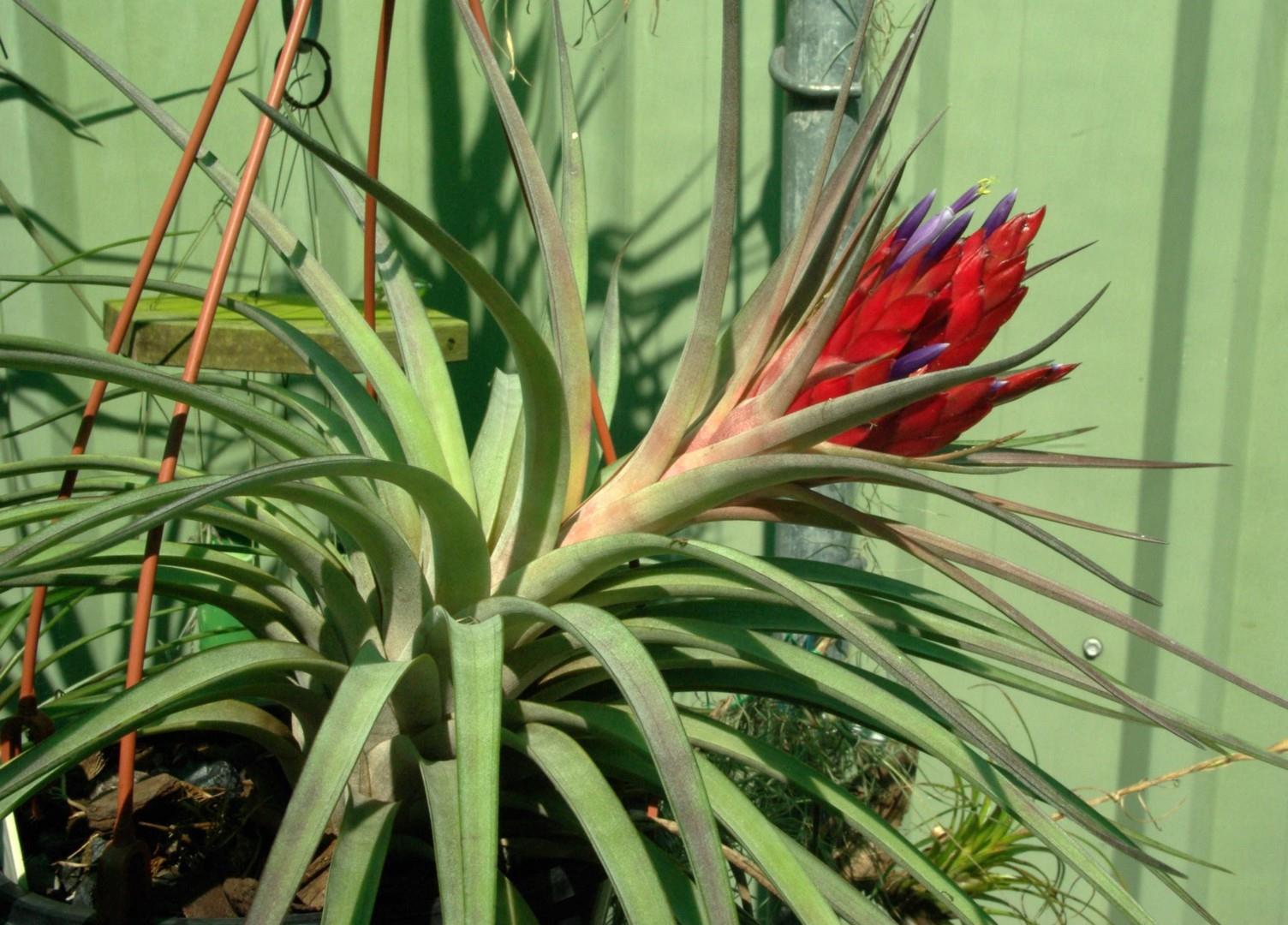 .
.
This is a plant that I got from John Buchanan in 2006 with the name tag attached. (fasiculata minor x Nidas).
I remember plants with similar breeding and background being discussed on a previous occasion and the name 'Hal's Nidus' being bantered around.
Please advise if the formular name on this plant is still current or has it now got a cultivar name.
Mark Supple 12/05/15
Yep it's the same as we got from Len in Melbourne years back but the label only had fasciculata minor on it.
Bob Hudson 12/05/15
There is another Tillandsia floating around down in Brisbane and it is labled Tillandsia fasciculata x velutina
Chris Larson 12/05/15
We have looked at the Pine Grove plant before. I know that I posted it, and Ross and Chris & Anna said that it was a different plant from T. Hal’s Nidus.
T. Hal’s Nidus was originally labeled T. fasciculata v. minor when I got it (a mature plant) from Hal’s son around ‘82 to ’85 (Hal died around 80-81). From me it went to Len – then Maurice, Mick, and on to Mark, etc
…. Then Renate at the SA conference circa the mid ‘90s (95?) who looked at a post floral plant and photo in bloom & called it T. xnidus. So I changed the name but others didn’t. Then it was speculated that it wasn’t T. xnidus – and some thought it was T. fasciculata X velutina - and I know that some changed their label to that. Then there was a discussion in the Till. group to say we would call it T. Hal’s Nidus.
Note that there were people that didn’t change their labels as the naming stuff went on, and there were those that changed their labels when they shouldn’t have.
I am unsure that the T. fasciculata X velutina floating around Brisbane is actually T. Hal’s Nidus – only that I know some changed their label to this in the interim and I know not if these labels were changed again to T. Hal’s Nidus.
Sometime around 5 years ago (?) I got a plant from Ross. It had no label. I speculated that it was T. Hal’s Nidus as it felt & looked the same. In flower it proved to have what I consider minor differences to T. Hal’s Nidus though others said that these were greater than I thought. Note: especially the scape length. This plant in Greg’s photo above looks to me to be Ross’s plant. Ross …?
I have been of the opinion, since flowering Ross’/Buchanan’s plant, that it was probably from the same batch (imports or seedlings) as T. Hal’s Nidus. Of course this is pure conjecture.
Also on the Bromeliads in Australia website there is a photo (by Ken Woods) of a plant from Qld "Possibly hybridised by Barry Genn, and labelled as such by Neville Ryan." Which looks like the one I have from Neville which is labeled T. xnidus and I do not think is the same as T. Hal’s Nidus or Ross’ plant.
Of course, when you get a natural hybrid – do they all look the same? Though we don’t have a record of where T. Hal’s Nidus or Ross’ plant originated from.
Ross may comment further as to whether he thinks that this is the same as his plant. & does it deserve another name???
PS – on the topic of T. fasciculata v. minor – there is a plant that is very common in Queensland collections being grown under this name. Does anyone have a picture of it flowering or know of its origins ?
Derek Butcher 13/05/15
- Bob Hudson: Thanks for alerting me to yet another name/formula floating around that has not been properly looked at.
I enclose what I knew about the saga of Hal's Nidus. (See DD1209 above).
It is based on what we knew 'down South'. Hence I am interested in the new reference to Pinegrove.
Bob Hudson 13/05/15. Images  ,
,  .
.
Photos of my Tillandsia fasciculata x velutina
Greg Aizlewood 13/05/15
Hi Bob, There appears to be a range of similarities (to my fasiculata Minor x Nidas) in particular the shape of plant, the shape of the leaves, colour and shape of the inflorescence yet the inflorescence does not seem to protrude as far out on the plant you are showing. It may be that your plant will extend further as it gets closer to flowering. If so I believe they are the same plant. May have to pull the flower apart to see if there are any differences there?
Chris Larson 13/05/15
Hi Bob & Greg: I haven’t got fasciculata X velutina or seen it in flower before – but this one appears to be closer to T. Hal’s Nidus than the Buchanan plant – though from what Barry says, it is still different again. We have traced provenance of the fasciculata X velutina back to Heather S. around 1990. Can you remember where you got it from Heather, and/or the name you got it under? – I’m assuming it was a different name as T. velutina wasn’t described until 1994?
Derek Butcher 14/05/15
Greg: We await Ross for details of what is in the Pinegrove ledger. It is a pity this is the only reference we can go to. We know about Hal's Nidus down here and have some sort of provenance but I have some questions to ask:
1. What does T. fasciculata minor look like? Who has got a photo of it in flower. It has not been recorded by botanists. So, it is nn if from the wild or NN if a cultivar. It seems to have its origins in Qld. I got such a plant from Keith Golinski many years ago but never flowered it so could not challenge him.
2. We know that T. xnidus is difficult to identify so WHO in Qld will own up to crossing a T. fasciculata minor with a supposed nidus.
3. There is a possibility that someone just guessed the formula hoping no-one would ask questions.
Ross Little 14/05/15
Hello Derek: This is what is on the label - Tillandsia fasciculata hybrid - Guatemala, BBK #2662, 5/86 Gleeson.
This is the plant that Chris got from me years ago which we have discussed here in the past.
I agree with Derek (point 3) someone guessed the formula there after.
Derek Butcher 14/05/15
Ross: Thanks for lead, BUT do you link your plant with Hal's Nidus so I can add a note to the record ? It would certainly save a lot of hassle. Interesting that yours came from Guatemala so many years ago and even though nidus has only been reported from Mexico you would think that fasciculata x ionantha (it's supposed parents) must have occurred elsewhere.
I assume you are not growing T. fasciculata minor and it must be over the border. Chris tells me he is growing seedlings, I assume to see if it breeds true so someone must be growing it but at the moment I am not being swamped with photos.
Ross Little 14/05/15
Derek: I have not got a Hal’s Nidus for me to be able to do a comparison to link the two so I would only be going by the photos, I’ll let others make that judgement call at this stage.
No I’ve not got any plants tagged as fasciculata minor.
Chris Larson 14/05/15
I am surprised that no one has commented on the source or supplied a photo of this plant (fasciculata var minor). I’ve seen the plant in many collections around Brisbane.
John Olsen 14/05/15 Images 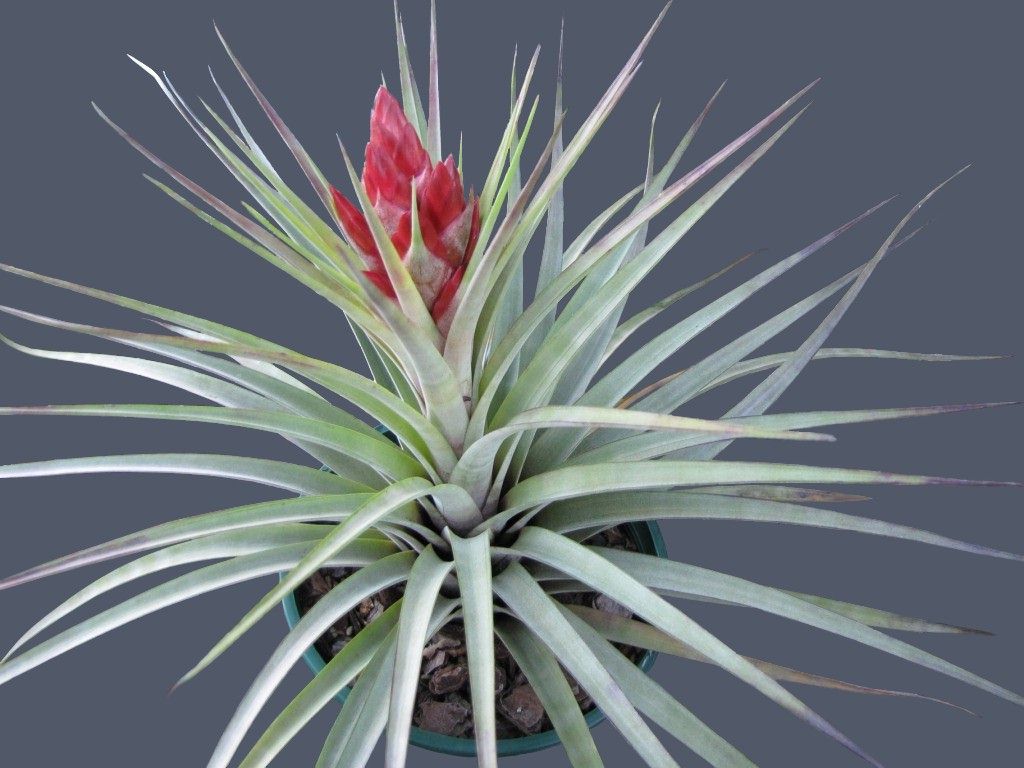 (velutina x fasciculata),
(velutina x fasciculata),  ('Coqette')
('Coqette')
Chris’s comment got me off the couch and down to the computer to check my files.
I think that T. fasciculata minor is so unspectacular that no-one has bothered to photograph it. I have the plant – it has flowered. The plant is a bit smaller than the velutina x fasciculata labelled plants I have, narrower leaves and a single spike inflorescence.
I do have some photos to further the discussion. The first is yet another labelled velutina x fasciculata, second one is a somewhat similar plant but comes with provenance ex BRT TX 137 bought at Cairns BSI Conference. It adds two more parents to the discussion.
Geoff Lawn 14/05/15
How easily we forget. Whilst researching another query, on Bromeliad Society of Australia website under "Detective" heading, there is a comprehensive article, DD1209, from 5 years ago about Till. Hal's Nidus with 2 photos by Mark Supple of allegedly Till. fasciculata "Minor" at the end.
It seems those photos titled Till. fasciculata "Minor" later became captioned Till. 'Hal's Nidus' for the BCR entry.
Barry Genn 14/05/15
This plant (Ed. fasciculata var minor ?) does vary quite a bit with varying culture, mainly in height, the stronger the light the more compact the growth and flower.
My thoughts are that there is no way that one of the parents is ionantha and hence it can't be a Nidus.
John Olsen 15/05/15 Images  ,
, 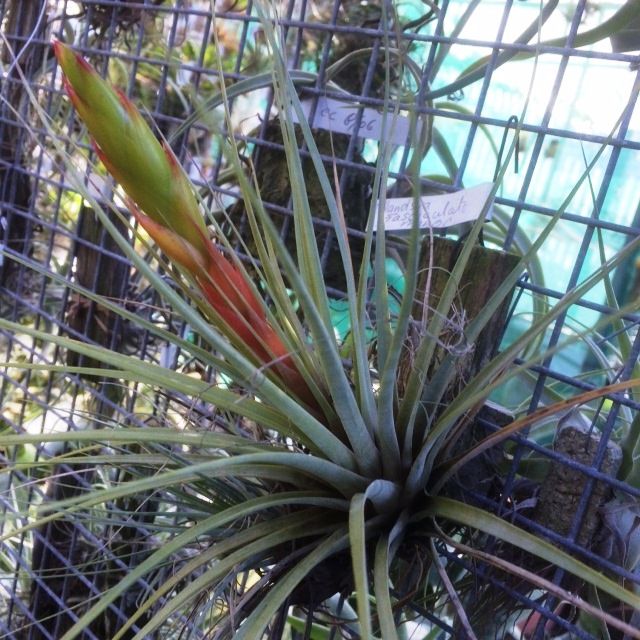
Guess what. My plant (fasciculata Minor) tucked away is flowering. My source was local.
Derek Butcher 15/05/15
John: That really puts the cat amongst the pigeons. It seems like we will have to register a Tillandsia 'Minor' once we know what it looks like.
Hal's Nidus and others called fasciculata minor look like they have some rotundata genes and thus linked in some way to 'Coquette' said to be a natural hybrid from Guatemala.
Derek Butcher 15/05/15
As you will have seen, I am chasing the T. fasciculata minor but we now have a chance to solve the 'velutina x fasciculata' problem which has already been quoted in reverse.
So here is a plea to Pam to give it a name and register it.
Pamela Koide-Hyatt 15/05/15 Images 
My plant labeled TX137 is from Wally Berg, received in July of 1996, as T. rotundata x capitata, natural hybrid from Guatemala, later named - T. Coquette.
Here is my photo and it looks similar to the ones posted.
Derek Butcher 15/05/15
Thanks Pam. Things are beginning to gel. How the plant got (velutina x fasciculata) on the label is anyone's guess. The problem is how to address the situation when in say 2 years time this formula crops up again. Because I have a gut feeling that Hal's Nidus is linked to this natural hybrid I will add a note to my record of this. Perhaps Ian can make a note in Bromeliads in Australia. Any other suggestions as to ways out of this dilemma gratefully received. Otherwise, I suggest that if Aussies have this formula on their label you concentrate on the TX 137 and thus to 'Coquette'.
Ron Jell 18/05/15 Images 
re: fasciculata minor.
Barry Genn 18/05/15
Yes Derek. Now we are getting there thanks to Pamela. This is exactly how the plants look here grown in strong light, more compact than in lower light conditions. The (velutina x fasciculata) was more of a guess as to the parentage, as is Nidus. I always suspected that this was a natural hybrid. I have never been able to self it or breed with it. I would suggest that we use 'Coquette' on these plants.
p.s. I may be able to muddy the water on this one in a few years when I flower my seedlings of velutina x fasciculata.
Derek Butcher 20/05/15
I have decided to bite the bullet on this name. If you have anything to add please advise.
Derek Butcher 31/05/15
No further comments received so this will now be registered. Don't forget to note your labels.
"Tillandsia ‘Minor’ by Derek Butcher, May 2015
"There are 2 completely different looking plants with this name circulating in Australia. One has been given the name of ‘Hal’s Nidus’ and seems very close to the natural hybrid from Guatemala called ‘Coquette’. The other one looks like a single spiked T. fasciculata. To try to save confusion this will be registered as Tillandsia ‘Minor’. The plant is about 20 cm in diam and flowers to about 20 cm high.




| Greg Aizlewood 12/05/15 |
Bob Hudson 13/05/15 |




| John Olsen 14/05/15, velutina x fasciculata |
John Olsen 14/05/15, Coquette_a |
John Olsen 15/05/15, fasciculata Minor |


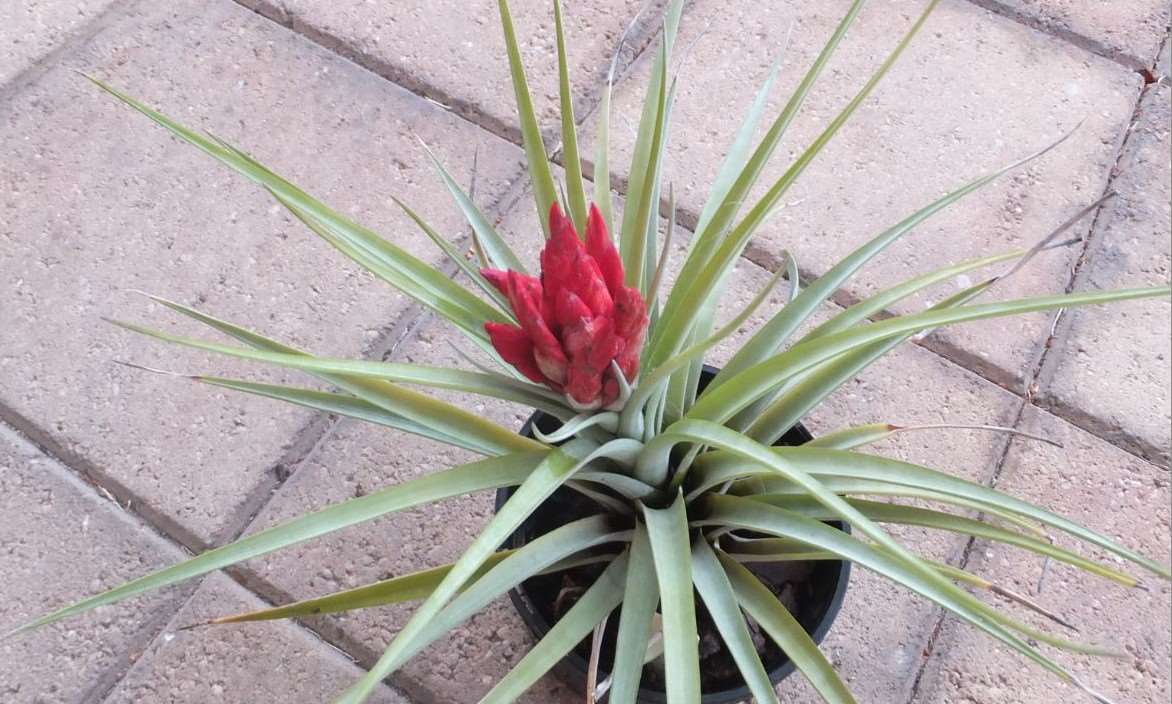
| Pamela Koide-Hyatt 15/05/15, Coquette |
Ron Jell 18/05/15, Minor |
Adam Bodzioch 01/21* (Hal's Nidus) |
*Adam Bodzioch ... "A plant bought a few years ago as T. fasciculata Minor X Nidus – is this the correct name?"
Chris Larson ... "The plant T. fasciculata v. minor was bought by me from Hal Ellis' deceased estate circa 1982. Hal imported many plants & was well connected throughout the country.
In 1995 Renate Ehlers told me it was T. x nidus at the Adelaide Conference.
Later on (probably 2005-ish) we decided to call it T. Hal's Nidus as it was thought to be neither a fasciculata or nidus.
So your plant is T. Hal's Nidus.
For all those putting up photos on Facebook as T. fasciculata x velutina etc which look more or less the same as this - these were names others had created to use with (unnamed) plants that had originated in, or were imported into, Australia around the same time as T. Hal's Nidus - these names are usually assumptions, not based on knowledge of what went into the hybrid. (Whenever we have been able to get provenance they trace back to late 70's, early 80's.) Very slight differences, but essentially the same plant (maybe a grex or a hybrid swarm). These are also being called T. Hal's Nidus."
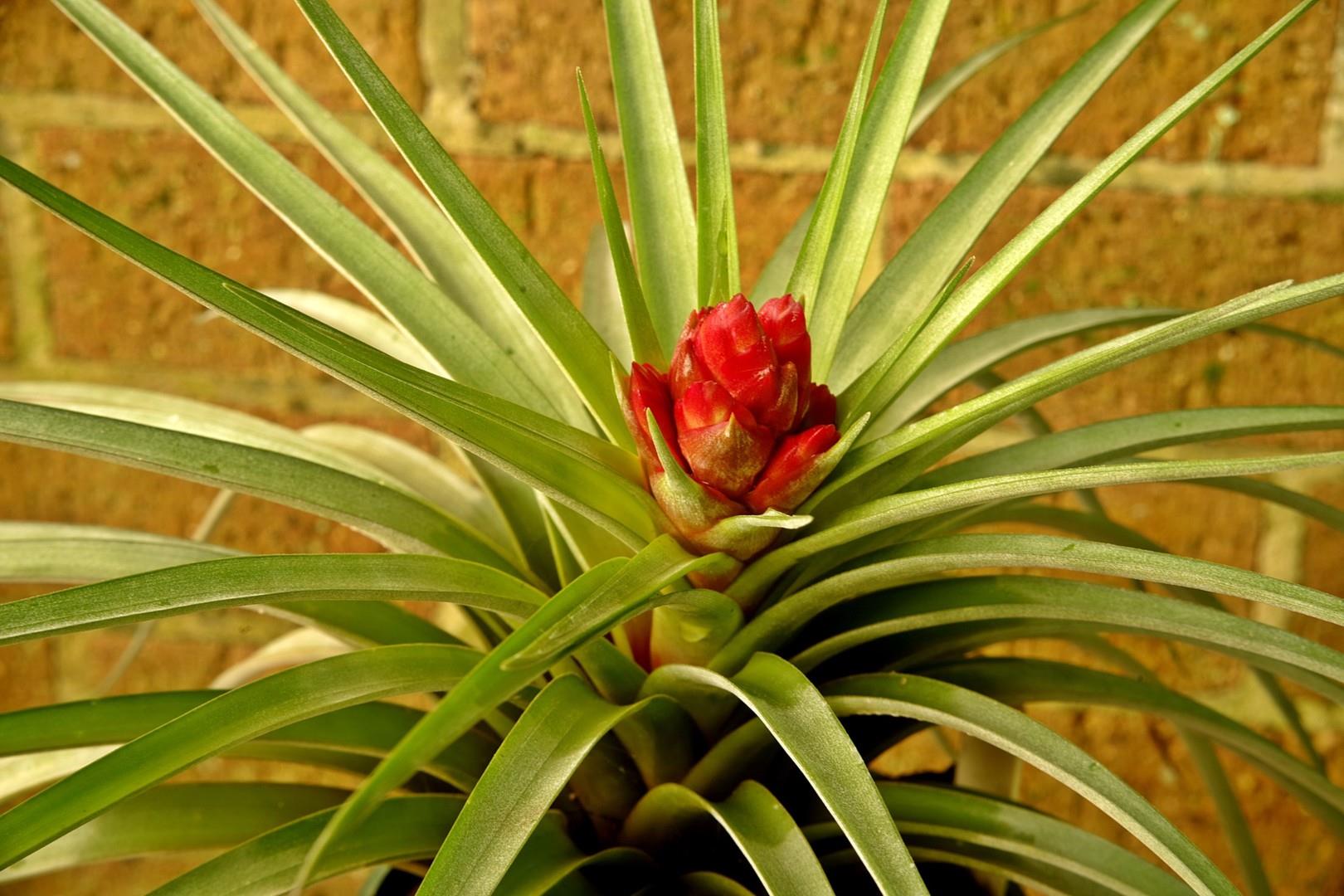
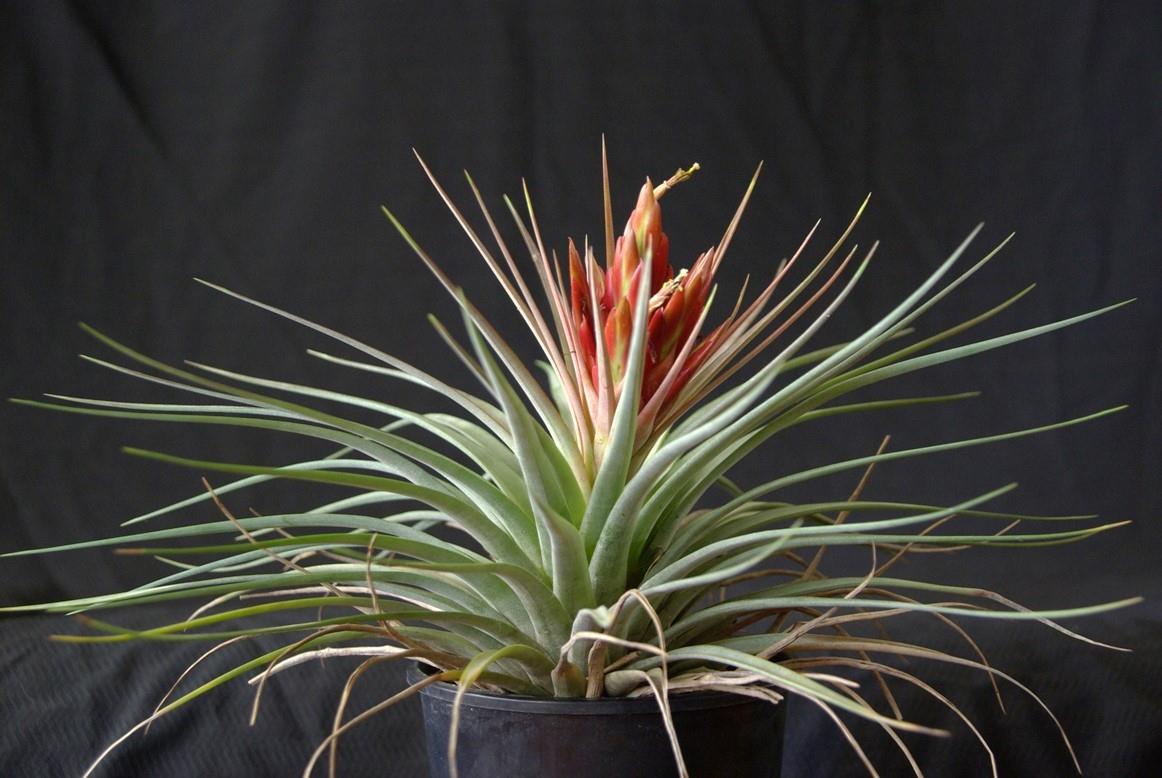


| Greg Aizlewood 03/24 as T. velutina x fasciculata |
Chris Larson What is the source on this one ?
Greg Aizlewood It came from Graham Sait who was a Guzmania grower up here but unfortunately he passed away last year I can check with Nev when I see him next and see if he can help.
Chris Larson just that it appears that this seems to all go back to early 80s & the Hal's Nidus era - where there are a few different clones appearing across Australia, and names made up to suit - or the separate plants from Tropiflora. Just an interest of mine.
Greg Aizlewood Hi Chris, Further to T. velutina x fasciculata = T. Hals Nidus.
I would like, at this point to say I agree that the original plant I tabled at the Till meeting in Cairns at the Conference in 2008 labeled T. Fasciculata minor X nidus. The plant was considered to be T. Hals Nidus. However, as you can see the shape and form of the bracts differ from the plant posted recently. Your thoughts please.
Updated 11/04/24
 ,
,  .
.





 ,
,  .
. (velutina x fasciculata),
(velutina x fasciculata),  ('Coqette')
('Coqette') ,
, 






